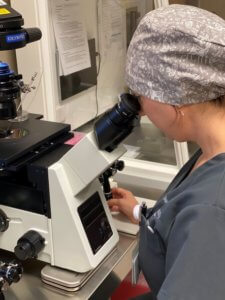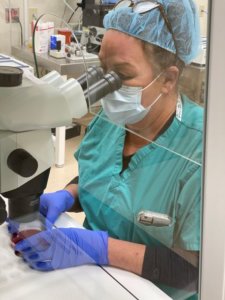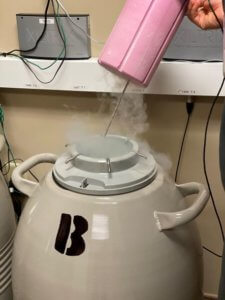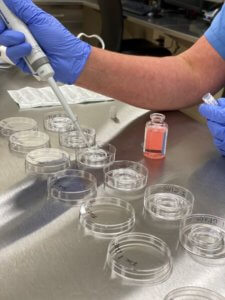The work of an embryologist is incredibly interesting but requires a lot of skill

Being an embryologist is probably one of the coolest professions ever. Every single day, we get to initiate and witness the beginnings of life. We’re the ones who see fertilization happen. We watch as that fertilized egg becomes a two-cell zygote to a 100-plus cell blastocyst five or six days later and ready for transfer. And we rejoice every time a patient receives a positive pregnancy test.
“My favorite part of being an embryologist is being able to make people’s dreams of having kids become a reality,” says Fertility Answers/Ovation Fertility senior embryologist Trisha Adams. “It is such a joy and pleasure to be a part of contributing to our patient’s goals of creating a family!”
But our job is not for the faint of heart. Because we have the important task of nurturing and caring for our patients’ embryos created during IVF cycles, an embryologist must pay close attention to detail and maintain composure under pressure. There are so many things that we do that can be stressful and we have to be able to troubleshoot quickly when clinical changes are made. But our biggest strength is being patient. Many of our tasks are micro-manipulation techniques performed under a microscope and can take years to perfect.
Let us give you a peek into the typical day of an embryologist
It’s 5:30 a.m. and as we prepare to get ready to go into work, we are also mentally preparing for our day ahead in the Fertility Answers/Ovation Fertility IVF lab. There will be eggs and embryos to freeze. We’ll need to check on embryos that are culturing to see how well they are growing. And we’ll need to communicate the status of those embryos to their anxious moms and dads. A few egg retrievals and embryo transfers on the schedule, so there will be eggs to freeze, ICSI fertilization procedures, embryo biopsies, and frozen embryos that will need to come out of the cryo tanks to be warmed and prepped. Another busy day, better get moving!
At 7:00 a.m. we arrive at the lab. Time to get busy! The first thing that we do in the morning is quality control or “QC” to make sure that all of our lab equipment is working properly. Multi-tasking is key to becoming a successful embryologist. “We may go from moving oocytes from one dish to another to taking apart a piece of equipment to repair it.” says embryologist Dr. Mariah Markle. “We often wear many hats!”
After QC, we make a plan for the day, deciding which tasks are most urgent and plan the entire day out in the most efficient way possible. An embryologist must be detail-oriented and organized. We often joke that our personal lives are so unorganized because we spend all our efforts being so organized at work.
First on the schedule is checking the growing embryos in their warm little incubators that are kept at a constant temperature of 37 degrees Celsius, or normal body temperature of 98.6 degrees Fahrenheit. We take each patient-specific bar coded dish out of their compartment and place under our high-powered microscope, making notes on which ones are dividing as expected and which ones have reached the blastocyst stage of around 100 cells at day 5 or 6.

Next on the schedule are several egg retrievals. We get busy prepping our area, gathering prepared dishes containing special media that the eggs will go into as the clinical staff performs the procedure. After the doctor extracts the fluid from each mature follicle this will be passed to us in the lab where we are waiting to look at the fluid under a microscope to find the egg. At the end we give a final egg count, always the most anticipated part of the procedure.
Now that we have the eggs from the patient, we let them culture in their dish for a bit and then it’s time to fertilize them. Using the sperm collected from the partner, we literally chase down a sperm under a microscope to suck up in our pipette. Then we inject this sperm directly into the cultured egg in a procedure called intracytoplasmic sperm injection, and voila! Fertilization! Now we let Mother Nature’s magic happen and away they go into their incubator. We then set up a schedule for the fertilized egg to be checked on days 1, 3, 5, and 6.
Hey, did we forget to eat lunch?
One of our favorite tasks is assisting with embryo transfers. Most of our transfers involve embryos that have been frozen, so our prep work typically involves thawing these embryos in a controlled environment and monitoring their thawing process.
We love embryo transfers and seeing the anticipation and hope on our patients’ faces. “Once, just before a frozen embryo transfer,” remembers embryologist Dr. Whitney Gaspard, “I removed the embryo from the incubator to set up for the transfer. The embryo had improved so much from the initial warm that I smiled so big it got the attention of the clinical staff in the next room. The embryo was visible on a monitor where the patients could see. The partner walked over to the window to see the screen and his wife sat up in the stirrups to get a better look. They were so happy!”

The rest of our afternoon is filled with embryo biopsies on blastocysts which means lots of microscopic work and patience. Embryo biopsies for pre-implantation genetic testing take years for an embryologist to perfect and involves clipping a few cells from the outer layer of the embryo, called the trophectoderm, that are destined to become the placenta. We then send these cells to be genetically tested to make sure they have the right number of chromosomes. Additionally, if a couple knows they are carriers of a particular genetic disease, we can have the genetics lab test the embryos specifically for that.
We then freeze these biopsied embryos in our special cryo tanks as we await the results from the genetics lab. Our cryo tanks are kept at a constant temperature of -321 degrees Fahrenheit using liquid nitrogen. The embryos are placed in specially barcoded containers on canes that get submerged into the liquid nitrogen to flash freeze them. “I sometimes cannot believe that we are able to do the things that we do,” says senior embryologist Lindsay Ramey. “It is sometimes crazy to think that we are able to freeze these embryos, thaw them at a later date, and make a baby.”
Always planning for the day ahead

“An embryologist is always one day ahead,” says senior embryologist Julie Dupre. “Meaning we are always setting up and preparing for the next day’s tasks.” This includes preparing all the necessary paperwork and dishes for the next day’s procedures. All of the dishes that will house eggs and embryos require a certain amount of time to equilibrate in the incubators and need to be made the day prior to any scheduled procedures.
The end of the day also is filled with patient communication and a lots more paperwork. We are also checking supplies and checking the level of liquid nitrogen in all of our cryotanks. And did we mention paperwork? Always lots of paperwork! But as demanding and hectic as our jobs are, we wouldn’t trade being an embryologist for any other job in the world. There are times that we gasp or praise out loud at how beautiful embryos are! And the anticipation that these beautiful little embryos will bring so much joy to a family that we are helping to create is overwhelming.
.


